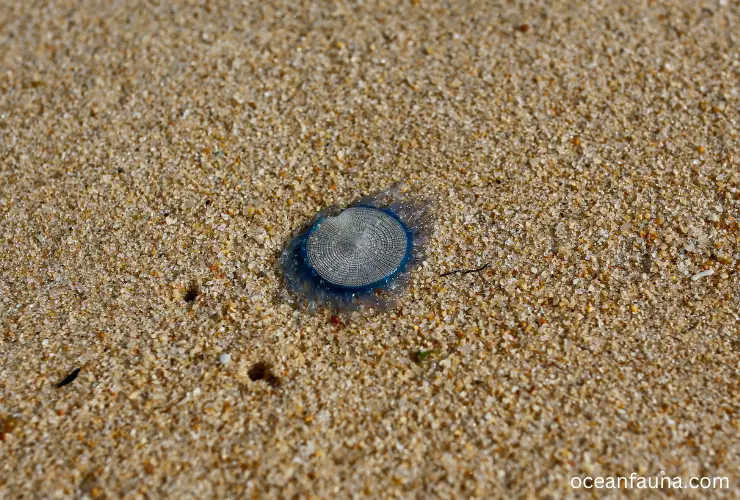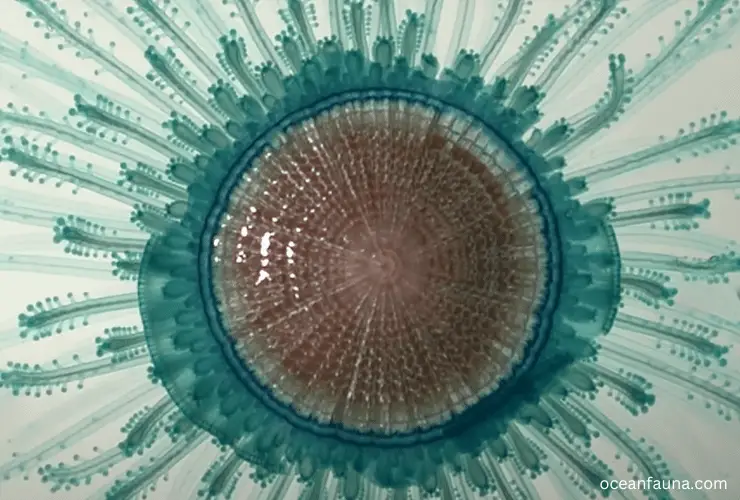Blue button jellyfish, scientifically known as Porpita Porpita, is a fascinating organism resembling a Christmas Star. These creatures are found in the tropical and subtropical waters of oceans worldwide. They are characterized by their bright blue, saucer-shaped bodies with a central mound surrounded by numerous tentacles.
Blue button jellyfish are a type of hydrozoan, which are colonial organisms made up of individual polyps that work together for the survival of the colony.
This article will unveil some interesting facts about Blue Button, covering their habitat, diet, and much more! So, let’s get started.
All About Blue Buttons- A Quick Biology
| Parameters | Details |
| Scientific name | Porpita Porpita |
| Kingdom | Animalia |
| Family | Chondrophores |
| Genus | Porpita |
| Phylum | Cnidaria |
| Class | Hydrozoa |
| Order | Anthoathecata |
| Species | Porpita Pacifica, Porpita porpita. |
| Habitat | Tropical, and subtropical waters of the world’s oceans. |
| Life Span | Unknown |
| Diet | Small planktonic animals. |
Description and Anatomy of Blue Button Jellyfish
The Blue Button’s body is composed of a gelatinous internal mass that is covered by a thin, translucent outer layer.
This outer layer is adorned with bright blue pigments that give the Blue Button its characteristic blue coloration.
The pigments are produced by specialized cells called chromatophores, which are capable of changing color.
Each tentacle of a Blue Button is lined with thousands of specialized cells called nematocysts, which contain tiny harpoon-like structures that can be used to capture prey or deter predators.

Physical Appearance of Blue Button Jellyfish
Blue Buttons resemble a Christmas star or a small blue pancake and are often mistaken for jellyfish.
These mesmerizing marine creatures are small, typically 1-2 inches in diameter.
Blue Buttons are divided into two main parts: the float and the hydroid colony.
The float is a hard, golden-brown, flat structure with a width of about 1 inch. The tentacle-like structure surrounding the float is the hydroid colony.
This central mound is surrounded by numerous tentacles radiating outwards from the disc-shaped body’s edge. The tentacles are typically between 12 and 20 in number and can vary in length.
Blue buttons have a single opening in their bodies beneath the float. Surrounded by a ring of gonozooids and dactylozooids, they use this opening to expel wastes and ingest prey.
Behavior of Blue Button Jellyfish
Blue Buttons are fascinating marine organisms that exhibit unique behaviors that help them to survive in their aquatic environment.
Because of nematocysts, these marine animals sting humans when they come in contact with human skin. Although the sting is mild, it can cause rashes and slight irritation in the affected area.
When a nematocyst is triggered, it expels a tiny, barbed thread that can penetrate the skin of the prey or predator and deliver a paralyzing toxin.
So, thanks to their specialized cells, Blue Buttons are also highly skilled predators.
Blue Button colonies have emerged in the Ionian and Adriatic seas as well as the coastlines in Japan.
The increase in its population can be attributed to the rising temperatures of oceans worldwide, an unusual occurrence that has been discussed later in this article.
Habitat, Range, and Distribution of Blue Button Jellyfish
Blue Buttons are found in warm and temperate oceans all around the world.
These animals inhabit the warm, tropical, and subtropical waters of the Pacific, Atlantic, and Indian oceans.
These animals are part of the neustonic food web, which means that they inhabit the ocean’s surface layer. They are often found in areas with high concentrations of planktonic animals, which they feed on.
Blue Buttons are typically found in the pelagic zone of the ocean, which is the open water column that extends from the surface down to a depth of approximately 200 meters.
They are commonly found in areas with warm water currents, such as the Gulf Stream. They can also be found in the Mediterranean Sea, the Caribbean, and other warm water regions.
Did you know? Blue Buttons prefer high levels of sunlight, which is necessary for the growth of the planktonic animals they feed on.
Feeding Habits/ Diet of Blue Button Jellyfish
Blue Buttons are carnivorous marine organisms that feed on various small planktonic animals, including copepods, krill, and other small crustaceans, including crustacean larvae.
One interesting aspect of Blue Button’s feeding behavior is their ability to feed on certain planktonic animals.
They have been observed to feed on copepods over other types of zooplankton preferentially.
Research suggests that Porpita Porpita adjust their feeding behavior in response to changes in the abundance and distribution of different types of prey. ~ Indian Journal of Geo-Marine Sciences
Life Cycle and Reproduction System of Blue Button Jellyfish
Since Blue Buttons are hermaphrodites, their life cycle begins with the release of eggs and sperm into the surrounding water by the adult polyps.
The fertilized eggs develop into free-swimming larvae. It is known as planulae, which eventually settle onto a suitable substrate and metamorphose into juvenile polyps.
Once the juvenile polyps have settled onto a substrate, they divide and begin to grow and develop into new types of polyp colonies. The polyps have specialized functionalities, including reproduction, defense, and feeding. ~ Iskenderun Technical University
The individual polyps within the colony are interconnected by a system of tubes, and each polyp is specialized for a specific function, such as feeding, reproduction, or defense.
This means that reproduction in Blue Buttons can occur both sexually and asexually.
Sexual reproduction involves the release of eggs and sperm by the adult polyps, which then fuse to form a zygote.
The zygote develops into a planula larva, which eventually settles onto a suitable substrate and develops into a new colony.
Asexual reproduction in Blue Buttons occurs through a process known as budding.
Adult polyps can produce genetically identical copies of themselves by budding off new polyps from their body, as mentioned above.
Despite their short life span, Blue Buttons can rapidly colonize new areas and be highly successful in areas with suitable environmental conditions.

Cardiovascular and Nervous System of Blue Button Jellyfish
Because Blue buttons lack vital organs including the heart, lungs, and brain, they do not have a circulatory or a cardiovascular system.
Instead, their gastrovascular cavity functions as digestive and circulatory organs.
Blue Buttons rely on a simple water vascular system to distribute nutrients and exchange gases throughout their bodies.
The water vascular system of Blue Buttons consists of a series of interconnected tubes and channels that are filled with fluid.
Water is drawn into the system through small openings on the surface of the polyps, known as ostia, and is then circulated throughout the body by the movement of specialized cells called cilia.
The exchange of water and nutrients from one cell to the next in the gastrodermis and water in the gastrovascular cavity is achieved through diffusion. This system ensures these nutrients reach all parts of the animal’s body.
The absence of an excretory system and organs means nitrogenous wastes are removed through diffusion from the cells into the water outside the animal.
Blue Buttons do not have a central nervous system but a decentralized nervous system composed of a series of interconnected nerve cells.
The nerve cells have long, thin fibers that are interconnected, forming a nerve net that responds to mechanical or chemical stimuli. ~ Manoa.Hawaii.edu
The nerves serve as transmitters, sending impulses to muscle cells that contract in response.
Thus, the polyps can move by contracting their bodies and forcing the water out through small openings known as sphincters.
One interesting aspect of the nervous system of Blue Buttons is its ability to respond to external stimuli.
The polyps can sense changes in their environment, such as changes in light or temperature. Besides this, they can respond to these changes through the coordinated activity of their nerve cells.
Importance of Blue Button Jellyfish in Ecosystem
Blue Buttons play an important role in oceanic ecosystems, serving as a source of food for other marine organisms and a habitat for smaller organisms.
These marine creatures serve as an important habitat for smaller organisms, such as crustaceans and small fish.
The branching, tentacle-like structures of the polyps provide a sheltered environment for these organisms to hide from predators and lay their eggs.
For instance, porpita porpita provides shelter to Malabar trevally, scientifically known as Carangoides Malabaricus.
The fish exhibits signs of panic if it is separated from its host.
Studies have shown that when the host and the fish are separated and returned to the same tank, they return to their former hosts.
These marine animals capture planktonic organisms from the surrounding water and convert them into nutrients that other members of the ecosystem can use.
In this way, Blue Buttons help to transfer energy through the food chain, providing a critical food source for many marine organisms.
Predators of Blue Button Jellyfish
Blue Buttons are a relatively small and delicate species, making them vulnerable to various predators in their marine environment.
One of the most common predators of Blue Buttons is the sea slug Glaucus atlanticus. Other predators include violet sea snails of the genus Janthina.
Sea turtles are also known to predate on Blue Buttons, particularly neonate loggerhead turtles. They are known to feed on Blue Buttons, especially in areas where they are abundant.
Relationship Between Blue Button Jellyfish with Humans

Like many marine species, Blue Buttons are facing a number of threats from human activities.
Pollution, climate change, and overfishing can all negatively impact their populations and the health of the marine ecosystems in which they live.
Efforts are underway to protect Blue Buttons and other marine species from these threats.
In addition to these conservation efforts, Blue Buttons and other marine organisms can also serve as a source of inspiration for scientific research and discovery.
Scientists have been studying the unique anatomy and physiology of Blue Buttons in order to gain a better understanding of the complex and intricate ecosystems that exist in the world’s oceans.
Blue Button Jellyfish Sightings at Beach Haven, New Jersey
Blue Buttons sightings have been reported at Beach Haven, New Jersey, a popular beach destination on the Jersey Shore. ~ WHYY.org
Research suggests that the sightings are due to an increase in the number of warm-water species migrating northward due to climate change.
Beach-goers have reported seeing large numbers of Blue Buttons washing up on the shore and other warm-water species such as sea turtles.
Blue Buttons are a tropical species typically found in warmer waters, so their presence in Beach Haven is likely a result of rising ocean temperatures.
This can have a ripple effect throughout the ecosystem, as temperature changes can alter the distribution and abundance of other species that depend on these ecosystems.
FAQs
Do Porpita Porpita sting?
Porpita porpita possesses stinging cells called nematocysts. However, these stinging cells are not typically harmful to humans and their sting is considered mild.
Are porpita porpita jellyfish?
Porpita porpita, commonly known as Blue Buttons, are often mistaken for jellyfish due to their appearance. They belong to a separate group of organisms called hydrozoans.
Can you touch a blue button?
While it is generally not recommended to touch any marine organism, it is usually safe to touch a (Porpita porpita) Blue Buttons.
Conclusion
If you first look at a blue button, you will confuse it with a mesmerizing blue-colored jellyfish.
But if you look closely enough, you will see that Blue Buttons are not true jellyfish even though they have a similar structure with a central disc-shaped body that is surrounded by tentacles.
Learning about and appreciating the unique qualities of marine organisms like Porpita porpita can help us better understand and protect these vital ecosystems for future generations.
